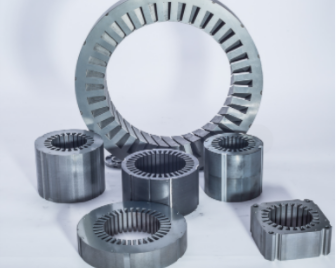 What are the advantages of ultra-thin silicon steel (0.1-0.2mm)?
What are the advantages of ultra-thin silicon steel (0.1-0.2mm)?
Nov 28, 2025
Ultra-thin silicon steel (with a thickness between 0.1 mm and 0.2 mm) is one of the core materials for current motor technology innovation. Its core advantage lies in achieving a "double" increase in motor energy efficiency, power density, and overall performance through "thinning" of the physical thickness.
• Improve energy efficiency and reduce iron losses. In motors, silicon steel sheets generate eddy currents due to electromagnetic induction, causing energy to be lost as heat; this loss is called iron loss. Ultra-thin silicon steel sheets can effectively limit the generation path of eddy currents, thereby significantly reducing iron losses.
•Achieving Miniaturization and Lightweighting
Ultra-thin silicon steel directly leads to the miniaturization and light weighting of both the material itself and the final application products.
Higher Power Output in the Same Volume: For applications highly sensitive to space and weight, such as drones, humanoid robots, and low-altitude aircraft, using 0.1 mm or 0.2 mm ultra-thin silicon steel allows motors to output higher power in the same volume, or to make the motor smaller and lighter while maintaining power. This is crucial for improving equipment mobility and endurance, meeting the demands of high-end applications.
•Core Advantages of Ultra-thin Silicon Steel in Different Application Scenarios
New Energy Vehicle Drive Motors: Its core advantage lies in low iron loss, improving motor efficiency, extending vehicle range, and making energy utilization more efficient.
Drone/eVTOL Motors: The core advantage of ultra-thin silicon steel lies in its excellent high-frequency performance, supporting miniaturization and light weighting, increasing motor speed and power density, and providing devices with better maneuverability and longer flight time.
Humanoid Robot Joint Motors: The core advantage of ultra-thin silicon steel in this area is its high magnetic induction and low iron loss, supporting precision control and miniaturization, providing the power foundation for precise movements of joints such as dexterous hands and waists, and contributing to improved motion performance.
Shunge Steel can now provide you with ultra-thin silicon steel in various specifications with thicknesses ranging from 0.1 to 0.2 mm. Welcome to inquire.
Read More

 What are the advantages of ultra-thin silicon steel (0.1-0.2mm)?
What are the advantages of ultra-thin silicon steel (0.1-0.2mm)?
 What impact does steel lamination punching have on motor performance?
What impact does steel lamination punching have on motor performance?
 What should be done before export silicon steel abroad?
What should be done before export silicon steel abroad?